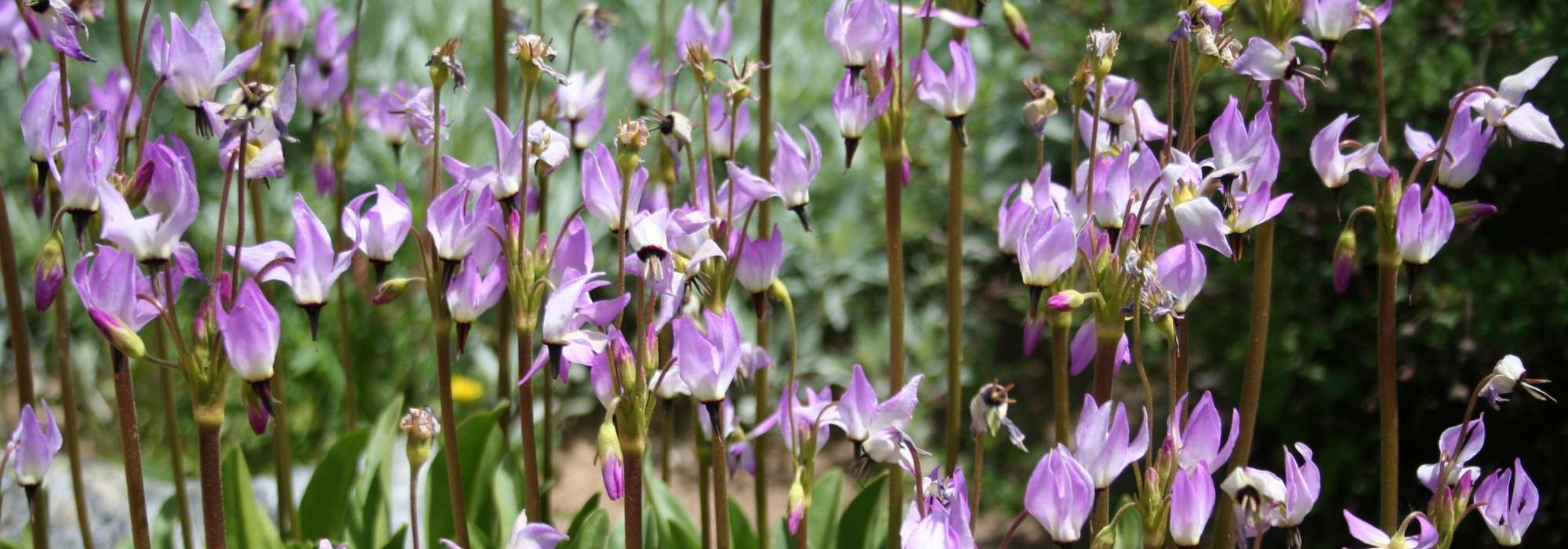
Shooting star, Virginia cowslip: planting, growing
Contents
The shooting star in a nutshell
- The shooting star is one of the prettiest spring flowerings!
- Its delicate, curled flowers resembling mini-cyclamens display charming shades of pink.
- This small, hardy perennial thrives in moist shade and requires acidic, consistently cool, and well-drained soil.
- Very hardy, it is easy to cultivate in a woodland under the foliage of trees.
- It also enjoys fresh rockeries, borders, or shady beds.
A word from our expert
The Dodecatheon or Virginia shooting star boasts one of the most beautiful spring flowerings! Still relatively unknown, this flower of rare beauty, previously appreciated mainly by discerning collectors, deserves a prominent place in all gardens, well sheltered under the foliage of trees.
In spring, this very elegant little perennial displays, with infinite grace, delicately turned-back flowers resembling mini-cyclamens in violet-pink or white.
Dodecatheon meadia or Virginia shooting star, as well as Dodecatheon pulchellum, all create somewhat sophisticated scenes imbued with freshness.
But don’t be fooled by their appearance: beneath this delicate facade lies a very hardy perennial that is easy to grow alongside other beautiful shade-loving perennials.
This moist shade perennial requires only dappled shade, coolness, and a rather acidic, cool, and well-drained soil to bloom generously before quietly disappearing in summer.
Charming and elegant, discover our shooting stars, these little botanical gems to collect; they will be perfect for dressing a shaded rockery, the base of trees, or a shrub border.
And get inspired to accompany them with our spring-flowering perennials!
Description and Botany
Botanical data
- Latin name Dodecatheon
- Family Primulaceae
- Common name Shooting Star, Dodecatheon
- Flowering April to June
- Height 0.15 to 0.40 m
- Exposure partial shade, shade
- Soil type acidic, cool
- Hardiness -15°C
The Dodecatheon, also known as Shooting Star, is a herbaceous perennial plant from the Primulaceae family, a relative of primroses and cyclamens, native to the cool undergrowth, wet meadows, and sometimes alpine regions of North America.
The genus comprises 14 species, among which Dodecatheon meadia, or Virginia Shooting Star, is the most widespread. It has given rise to some interesting cultivars such as ‘Queen Victoria’. Only four species are marketed in our country, and Dodecatheon jeffreyi, Dodecatheon hendersonii, and Dodecatheon pulchellum are rarely available for sale.
Slow-growing, the Shooting Star forms in spring a clump of upright leaves gathered in a basal rosette. It measures from 10 to 45 cm in height. Oval to lanceolate, spatulate or obovate, measuring 2 to 25 cm in length, the leaves are sometimes irregularly dentate. Glabrous or slightly velvety and fleshy, they resemble those of primroses. With a lovely soft green to dark green colour, they sometimes redden towards the petiole depending on the variety. The deciduous foliage regenerates in spring.
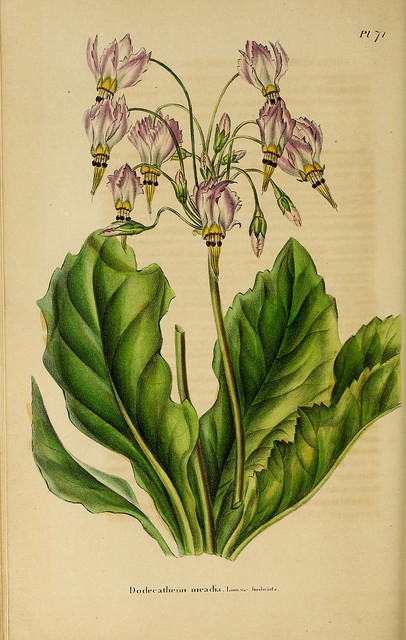
Dodecatheon meadia – botanical illustration
Graceful and infinitely delicate, the flowering of the Shooting Star is of rare beauty. From March to June depending on the climate, a multitude of floral spikes, fine yet vigorous, spring well above the foliage, sometimes reaching over 40 cm in height. At the end of these naked, pinkish-green stems, gracefully hang umbels of about fifteen flowers revealing a calyx of 5 completely reflexed sepals. Their unique shape, with narrow, lanceolate petals directed backward and long peduncled, unmistakably resembles that of mini-cyclamens.
As if suspended in the air and reaching towards the sky, they bloom in clouds of small, turned-back bells measuring 1 to 3 cm long in colours from pastel pink, cyclamen pink to raspberry or cherry red, and more rarely cream-white, these flowers are slightly white at the base. The heart of the flowers, very visible, reveals a pointed bouquet of 5 stamens fused together and protruding in deep purple or violet, edged with gold, orange, or white.
Like a celestial ode, this fairy-like flowering would pay tribute to the twelve gods of Olympus; in Greek, “dodeca” meaning “twelve” and “theos”, “gods”.
Like any good spring plant, the Shooting Star has a very short vegetative cycle, after flowering it enters dormancy, losing its foliage during the summer and disappearing completely.
Very hardy down to -15°C to -25°C, the Dodecatheon prefers cool, mountainous climates. This small perennial plant of wet undergrowth requires a filtered or partial shade exposure and humus-bearing, acidic soil that remains very cool or even moist during the growth period and well-drained.
Read also
Care of perennial plantsMain species and varieties
The Dodecatheon meadia or Virginia shooting star is the most widespread species, available in numerous varieties showcasing all shades of pink from pale to carmine, including white.
Our favourites
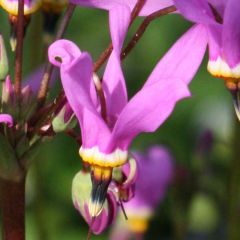
Dodecatheon meadia Queen Victoria
- Flowering time May, June
- Height at maturity 35 cm
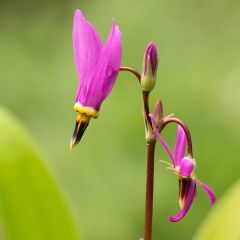
Dodecatheon meadia
- Flowering time May, June
- Height at maturity 30 cm
Discover other Dodecatheon
View all →Available in 1 sizes
Available in 1 sizes
Available in 1 sizes
Available in 1 sizes
Available in 3 sizes
Planting
Where to plant the shooting star or Dodecatheon?
From its montane origins, the shooting star has retained a good hardiness, being able to withstand temperatures from -15°C to sometimes -25°C. It thrives in rather cool climates and in a mountain garden.
While it withstands the cold well, this small moist shade plant has some cultural requirements, making it difficult to grow in Mediterranean climates, which can be a bit too dry. It should be protected from strong sunlight and dry soils.
This woodland perennial enjoys partial shade or bright shaded areas in non-calcareous soil, slightly acidic, rich in humus that remains cool, even moist during growth, and well-drained. However, it will appreciate a slightly drier soil during the summer dormancy period.
Think carefully about its location, as once well established, this plant does not tolerate transplanting well.
Plant it at the edge of a cool shady border or rockery, on the edge of woodland, or under the canopy of trees that will protect it from harsh rays, where it will form lovely ephemeral clumps in spring, albeit very floriferous.
Particularly enjoying moisture, it will also thrive on the edges of a pond.
When to plant the shooting star or Dodecatheon?
The planting of the Dodecatheon takes place in early spring in March-April after the frosts or from September to November.
How to plant the shooting star or Dodecatheon?
The soil must be well-drained and rich in organic matter to plant the shooting star. Space the plants 30 to 40 cm apart to allow the clumps to flourish comfortably and count 5 to 7 pots per m². As its foliage disappears early in summer, to fill the bare soil and take over after its flowering, consider planting some small summer bulbs or other perennials that enjoy cool to moist soils and shaded situations between two shooting star plants.
- Clean the soil well by removing stones, roots, and weeds
- Work the soil well by adding a mix of turf and leaf compost
- Dig a hole 2 to 3 times the volume of the pot
- Spread a draining layer of gravel or coarse sand
- Plant and cover the root ball with the fertile soil mix
- Water generously to encourage rooting
- Mulch in spring to keep the soil cool with pine bark

Dodecatheon redolens
Read also
Planting Perennials and BushesMaintenance and Care
Once well established, the Dodecatheon requires virtually no maintenance and proves to be a hassle-free perennial, capable of living for many years without any care, as long as the soil remains consistently moist, especially during flowering.
It does not tolerate overly dry soils well: if necessary, water regularly once or twice a week during the growth period to keep the soil consistently fresh.
After flowering, the leaves collapse onto the ground, and then the deciduous foliage disappears in summer, leaving the plant dormant underground, making it difficult to spot, but this is fine as it requires no watering during this period! That said, we recommend marking its location to avoid damaging it during weeding and to facilitate the fight against gastropods as soon as growth begins.
You may remove any faded flower spikes, which can be quite unsightly after flowering, and cover the stump with a carpet of dry leaves.
Resistant to diseases, it has only a few rare enemies: slugs and snails that devour the young leaves in spring. Follow our tips to keep them away naturally!
Multiplication
If sowing is possible, we recommend dividing the rosettes in spring from stumps that are at least three years old, to rejuvenate the plant and maintain beautiful flowering.
Dividing clumps of Shooting Star
- Using a spade, gently lift the clump to take a section with a rosette of leaves
- Replant immediately in the garden in well-worked soil to a good depth
Associate the shooting star with the garden
The Dodecatheon is the essential shade perennial to bring colour and freshness to the heart of spring, in a wooded garden, used as groundcover in cool undergrowth, beneath deciduous trees or bushes, or as punctuation in a damp shady rockery.
Graceful, with its pink flowers, and more rarely white, it blooms in all nature-inspired gardens, creating fresh scenes, in subtle or vibrant combinations. In a pink garden or romantic setting, pair it with hardy fuchsias, Dicentra spectabilis or bleeding heart.

An idea for a shady association: Dodecatheon meadia, Meconopsis betonicifolia, Lamium orvala, Geranium nodosum ‘Silverwood’, Hosta tardiana ‘Halcyon’, and you can complete with some clumps of Polypodium vulgare
It will work wonders when paired with cyclamen, white daffodils, snowdrops, erythronium, and other spring bulbs such as early tulips, scillas, and muscari, which will also be good companions.
Small shade perennials like primroses or violas will create delicate compositions with it.
In a shady rockery, near a water feature, it can be accompanied by Epimedium, pulmonarias, small ferns, astilbes, hostas, and rodgersias.
To cover a slope, it will pair perfectly with Corydalis, creeping bugle, or small groundcovers like Chrysosplenium oppositifolium, which will fill the gap left by the shooting star during summer dormancy.
And get inspired by our ideas for planting under your trees!
Useful resources
- What solutions to make the most of shade in the garden? Discover our tips on our blog!
- What to plant under your trees?
- The Gyroselle brings a touch of pink to the garden! Essential in a romantic garden!
- Very useful for filling a bare woodland area, a shaded bank, or dressing the base of a tree, fall for our unique collections of shade-loving perennials!
- Subscribe!
- Contents
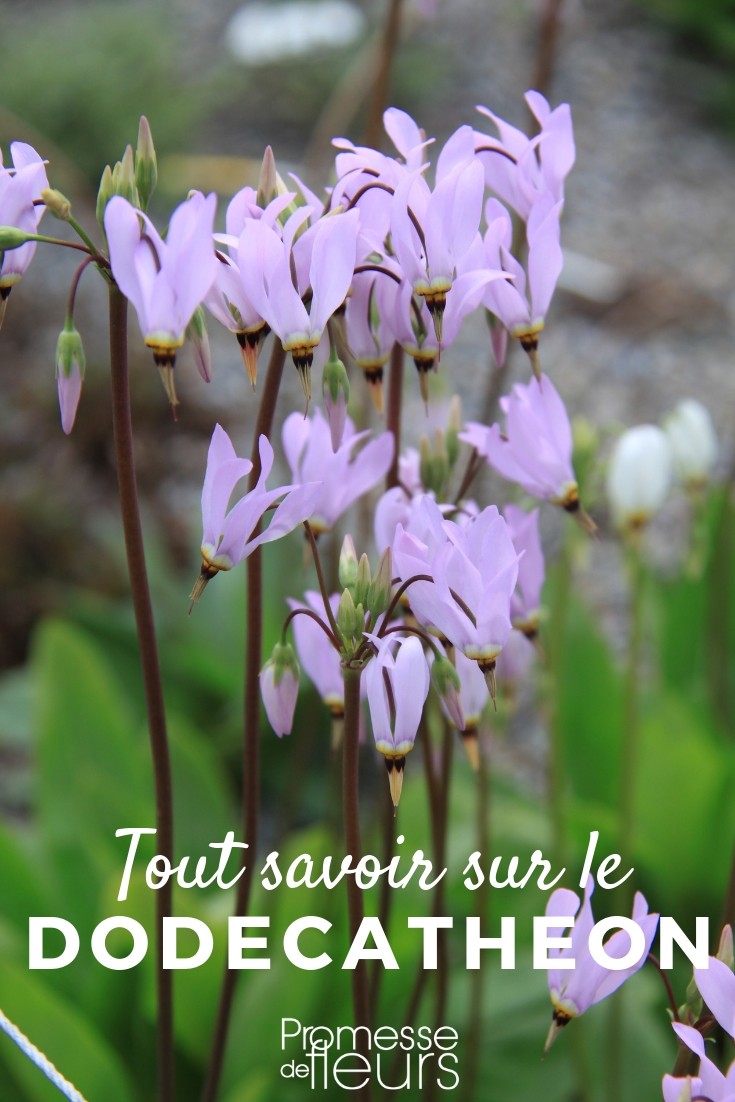































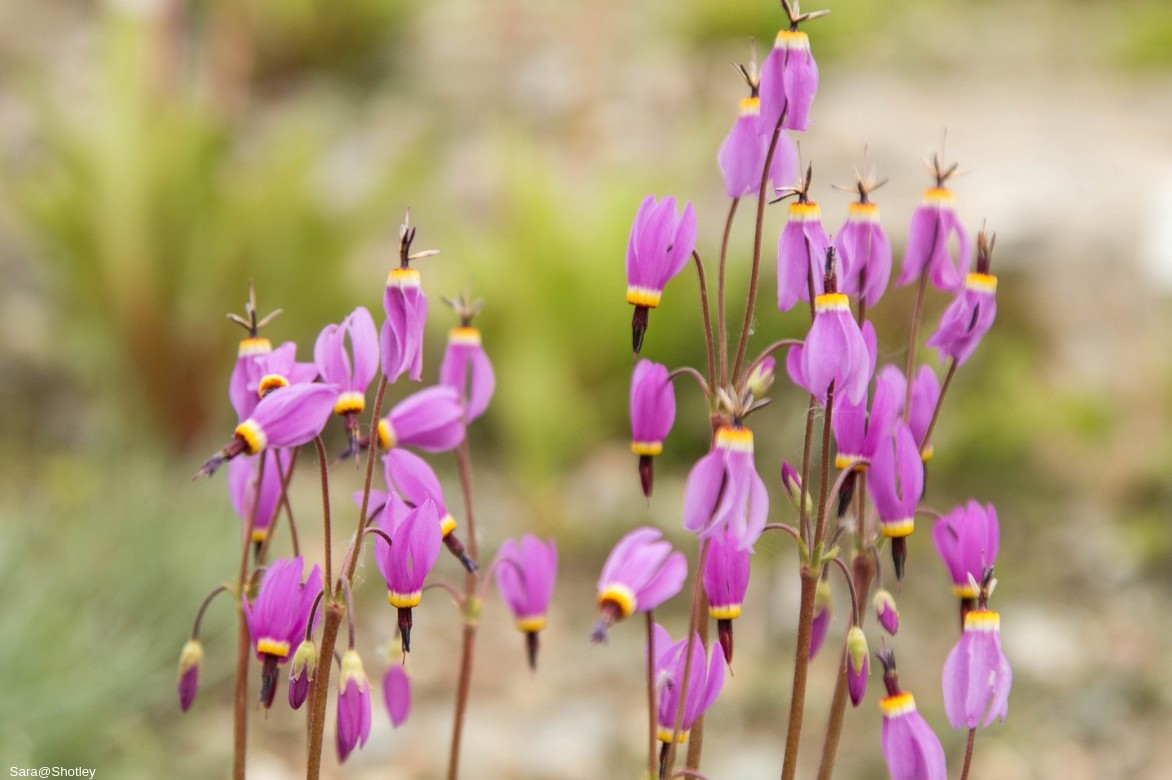
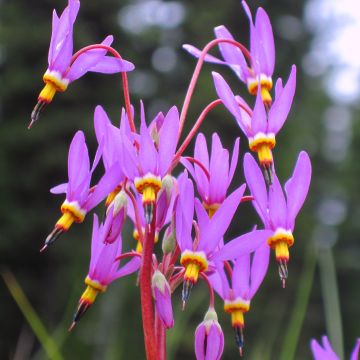


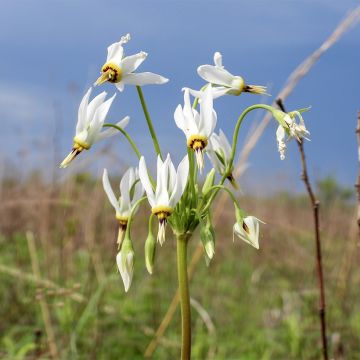
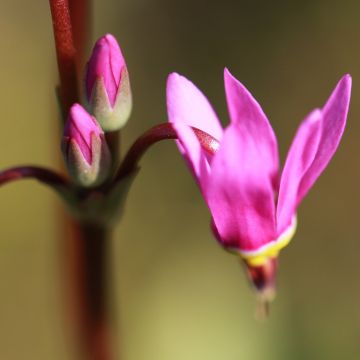
Comments